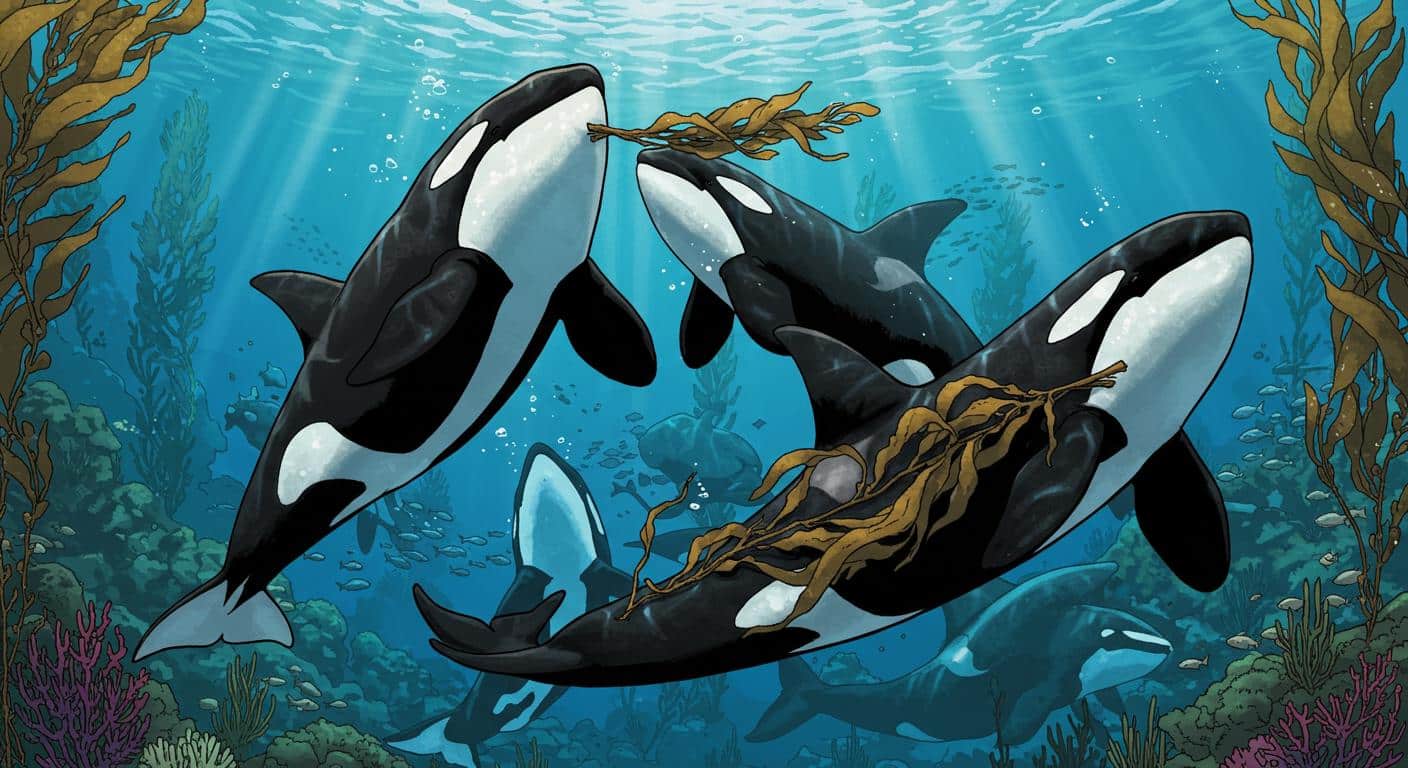In the vast archives of curious animal behavior, a new entry just swam in: orcas, those enigmatic black-and-white denizens of the Pacific Northwest, aren’t simply apex predators or cultural icons—they’re also, apparently, innovators in the realm of aquatic wellness. It turns out that southern resident killer whales in the Salish Sea have been documented giving each other what can only be described as kelp-based spa treatments. And, unlike most human spa fads, this one is truly all-natural.
Allokelping: Mutual Grooming Goes Aquatic
If the phrase “kelping hand” isn’t already taken, it certainly should be, as ScienceAlert details. With the help of high-resolution drone footage, researchers observed that orcas were snapping off precise segments of bull kelp—roughly the size of their beak-like faces—by grabbing them with their teeth and twisting vigorously near the rock bed, a process documented in both ScienceAlert and New Scientist. After crafting these kelp segments, whales were seen methodically passing, sandwiching, and rolling these bits of kelp between podmates. Rather than just draping seaweed over their backs, as has long been known in “kelping,” this population was intentionally selecting, sizing, and manipulating these plant-based implements to groom one another.
This newly observed behavior has been dubbed “allokelping” by researchers, blending marine resourcefulness with what comes across, as Michael Weiss of the Center for Whale Research described to multiple outlets, as a form of mutual aid serving both hygiene and social connection. Weiss notes that “pairs of whales can allokelp ‘on the go’, continuing to travel with the rest of the pod,” and suspects the targeted nature of the rubbing allows for greater precision than a solo swim through a kelp forest. One might say whale grooming has gone artisanal.
Spa Day, Pod Edition
New Scientist, after reviewing the drone footage, describes that allokelping was seen across ages and sexes in the endangered southern resident pod, although whales who were closest in age or had strong family ties showed a special fondness for partnering up—apparently even orcas prefer familiar company at the spa. Some grooming sessions lasted up to twelve minutes, and, as Rachel John of the research team pointed out, it’s not as though orcas are working with opposable thumbs; these sessions involved carefully orchestrated, deliberate movements relying entirely on body and teeth. The behavior was especially common among whales observed to be shedding their skin, hinting at a focused self-care agenda.
The question naturally arises: does kelp exfoliation come with extra benefits? John notes that contact maintains and reinforces social bonds within the pod and speculates that kelp scrubbing may help with general skin hygiene, perhaps even dislodging parasites. Olaf Meynecke, a marine scientist at Griffith University quoted in New Scientist, suggests it would be illuminating to investigate the interaction between kelp properties and orca skin bacteria, though emphasizes that such potential health benefits remain unproven at this stage.
Not Your Average Tool Use
The Guardian’s coverage underscores the significance of this finding in the broader context of animal intelligence. Tool use has long been one of the dividing lines we draw to measure cognitive complexity—think chimpanzees with their termite sticks or crows bending wire—but few marine mammals have joined these ranks. While dolphins have made headlines for using sea sponges to protect their beaks when foraging, killer whales, until now, hadn’t been seen using tools in such a nuanced, cooperative way.
According to the study published in Current Biology and reported by The Guardian and ScienceAlert, what sets this apart is not merely the use of kelp but its deliberate selection, modification, and manipulation by two animals in tandem—a step beyond solo spa treatments, making this a rare documented case of mutual tool use in marine mammals. Darren Croft, another senior researcher involved, drew direct parallels to mutual grooming in primates, where such tactile rituals have been shown to relieve stress and strengthen social bonds.
The Guardian further notes that this ritual appears culturally unique to this specific group. Some other orca populations have been seen rubbing against pebble beaches or even donning salmon hats (as described in New Scientist), but the kelp massage—complete with craftily tailored seaweed—seems particular to the southern residents. Regional spa specialities, one might say. Makes you wonder what quirky traditions are hiding in other orca circles.
Fragile Traditions in a Changing Sea
Even as researchers delight in this newfound behavior, the backdrop is sobering. As The Guardian also notes, the outlook for the 73 or so whales in the southern resident population is “very bleak.” Their chief food source, chinook salmon, is dwindling due to overfishing, environmental disruption, and the broad effects of a warming climate. The bull kelp itself, an essential piece of orca wellness equipment, is struggling to survive in hotter waters, placing strain on both the pods and the very substrate of their grooming rituals. Michael Weiss expressed concern that, should current trends persist, not only will this distinctive social behavior vanish, but an entire lineage of cultural knowledge and adaptation may disappear unseen.
The Unfathomable Depths of Whale Culture
What stands out here isn’t just the surprise of whales wielding kelp like a spa tool, but the reminder of how much is yet to be learned about animal societies. As Weiss commented to The Guardian, “these are probably the most monitored marine mammals in the world,” and yet major behaviors are only now coming to light thanks to advances in observation technology like drones. Monika Wieland Shields, director of the Orca Behavior Institute, highlighted that behaviors such as allokelping, though newly described, may have been quietly ongoing for generations.
Will future studies find variations of this practice among other orca groups—or entirely different social rituals never yet glimpsed by researchers? Is there a kelping technique out there that rivals the famed “salmon hat” in eccentricity? The ocean, it seems, may still be keeping most of its best stories to itself, leaving us to wonder just how many aquatic oddities are left uncovered beneath the waves.







